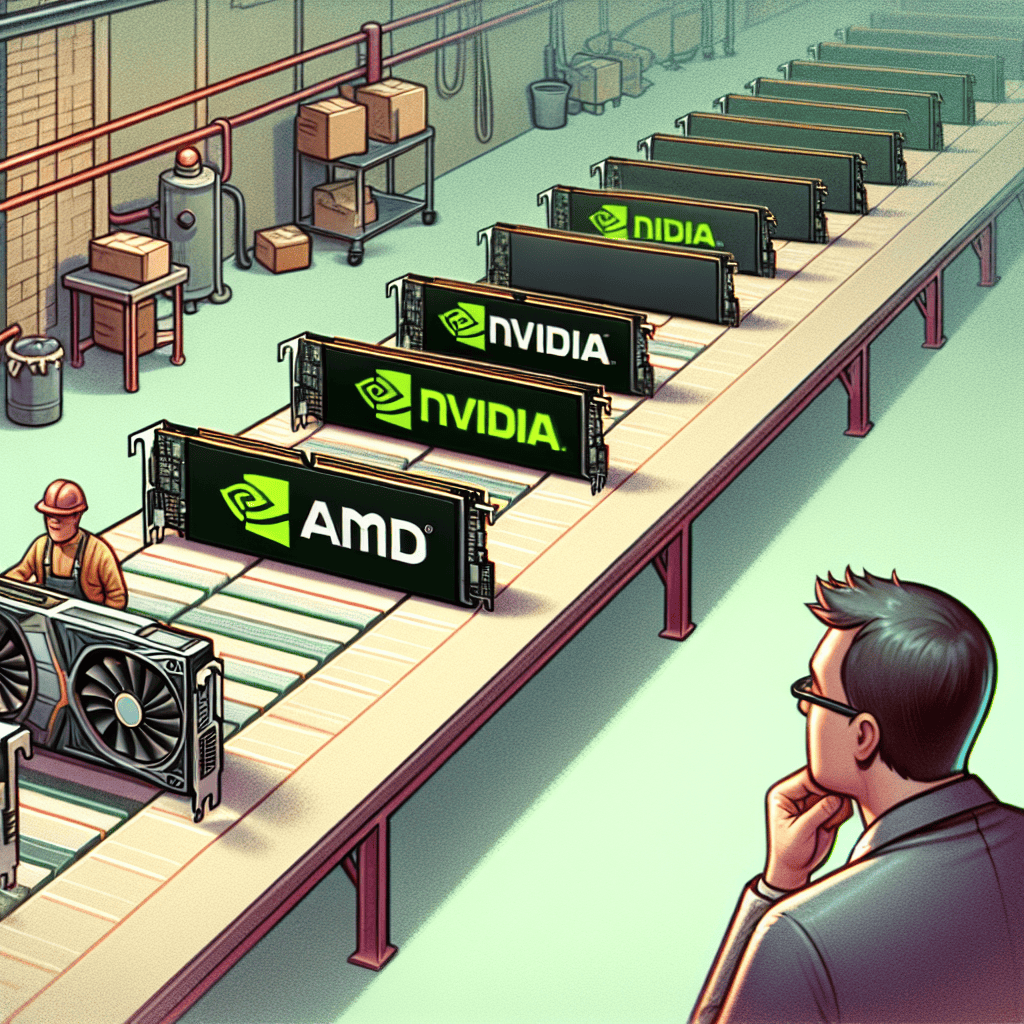“AMD’s Bold Move: A Catalyst for Nvidia’s Stock Surge?”
Introduction
In the rapidly evolving landscape of technology and semiconductor industries, strategic maneuvers by leading companies can significantly impact market dynamics and investor sentiment. Recently, Advanced Micro Devices (AMD) has made headlines with a bold move that has captured the attention of analysts and investors alike. This development has sparked discussions about its potential implications for competitors, particularly Nvidia, a dominant player in the graphics processing unit (GPU) market. As AMD seeks to expand its market share and technological prowess, questions arise about whether Nvidia’s stock now presents a compelling investment opportunity. This analysis delves into the ramifications of AMD’s strategic actions and evaluates whether they position Nvidia as a must-buy for investors looking to capitalize on shifts within the semiconductor sector.
Impact Of AMD’s Strategy On Nvidia’s Market Position
In recent years, the semiconductor industry has witnessed significant shifts, with major players like AMD and Nvidia constantly vying for dominance. AMD’s strategic maneuvers have notably impacted the competitive landscape, prompting investors and analysts to reassess Nvidia’s market position. Understanding the implications of AMD’s strategy on Nvidia requires a closer examination of the technological advancements, market dynamics, and investor sentiment that shape this high-stakes industry.
AMD’s resurgence in the semiconductor market can be attributed to its innovative approach and aggressive product development. By focusing on high-performance computing and leveraging advanced manufacturing processes, AMD has successfully captured a substantial share of the CPU and GPU markets. This strategic focus has not only enhanced AMD’s reputation but also intensified competition with Nvidia, a company traditionally known for its dominance in the graphics processing unit (GPU) sector. As AMD continues to roll out competitive products, Nvidia faces the challenge of maintaining its leadership position while adapting to the evolving market dynamics.
The impact of AMD’s strategy on Nvidia is multifaceted. On one hand, AMD’s advancements have spurred Nvidia to accelerate its own innovation efforts. In response to AMD’s competitive offerings, Nvidia has been compelled to enhance its product lineup, focusing on delivering superior performance and efficiency. This competitive pressure has led to the rapid development of cutting-edge technologies, such as Nvidia’s RTX series, which incorporates real-time ray tracing and AI-enhanced graphics. Consequently, consumers benefit from a broader range of high-performance options, driving demand and expanding the overall market.
On the other hand, AMD’s strategy has also influenced Nvidia’s pricing strategies. As AMD introduces cost-effective alternatives, Nvidia is prompted to reevaluate its pricing models to remain competitive. This dynamic has resulted in more affordable options for consumers, further fueling market growth. However, it also poses challenges for Nvidia in terms of maintaining profit margins and sustaining its premium brand image. Balancing competitive pricing with profitability becomes a critical consideration for Nvidia as it navigates this evolving landscape.
Moreover, AMD’s strategic moves have implications for Nvidia’s market perception and investor sentiment. As AMD gains traction and garners positive attention from both consumers and industry experts, Nvidia must work diligently to reinforce its brand loyalty and market confidence. This involves not only delivering superior products but also effectively communicating its value proposition to stakeholders. Nvidia’s ability to maintain its reputation as a leader in innovation and performance is crucial in sustaining investor trust and attracting new investments.
In light of these developments, the question arises: does AMD’s strategy make Nvidia stock a must-buy? While AMD’s advancements undoubtedly present challenges, they also create opportunities for Nvidia to demonstrate resilience and adaptability. Investors considering Nvidia stock must weigh the company’s ability to innovate, its strategic responses to competitive pressures, and its long-term growth prospects. Nvidia’s track record of technological leadership and its commitment to expanding into new markets, such as artificial intelligence and autonomous vehicles, position it as a formidable player in the semiconductor industry.
In conclusion, AMD’s strategic maneuvers have undeniably influenced Nvidia’s market position, prompting a reevaluation of its strategies and offerings. While the competitive landscape presents challenges, it also drives innovation and market expansion. For investors, Nvidia’s ability to navigate these dynamics and capitalize on emerging opportunities will be key in determining whether its stock remains a compelling investment choice. As the semiconductor industry continues to evolve, the interplay between AMD and Nvidia will undoubtedly shape the future of technology and investment in this critical sector.
Analyzing Nvidia’s Stock Performance Post-AMD’s Move
In recent years, the semiconductor industry has been characterized by rapid innovation and intense competition, with companies like Nvidia and AMD at the forefront of technological advancements. The dynamics within this sector have significant implications for investors, particularly when one major player makes a strategic move that could potentially alter the competitive landscape. Recently, AMD’s decision to enhance its product offerings and expand its market reach has prompted investors to reassess the potential of Nvidia’s stock. This development raises the question: has AMD’s move made Nvidia stock a must-buy?
To understand the impact of AMD’s actions on Nvidia’s stock performance, it is essential to first consider the broader context of the semiconductor market. Nvidia has long been a leader in the graphics processing unit (GPU) space, with its products being integral to gaming, artificial intelligence, and data center applications. The company’s ability to innovate and maintain a technological edge has historically driven its stock performance. However, AMD’s recent advancements, particularly in the GPU segment, have introduced new competitive pressures.
AMD’s strategic initiatives, including the launch of its latest GPU architecture and its aggressive pricing strategy, have been designed to capture a larger share of the market. This move has not only intensified competition but also compelled Nvidia to respond with its own innovations and pricing adjustments. Consequently, investors are closely monitoring how Nvidia navigates these challenges and whether it can sustain its market leadership.
In the wake of AMD’s move, Nvidia’s stock performance has exhibited resilience, underscoring the company’s robust fundamentals and strategic agility. Nvidia’s continued investment in research and development has enabled it to introduce cutting-edge products that cater to emerging trends such as machine learning and autonomous vehicles. Moreover, Nvidia’s strong partnerships with major technology firms and its expansion into new markets, such as cloud computing, have further bolstered investor confidence.
While AMD’s actions have undoubtedly increased competition, they have also highlighted the growing demand for advanced semiconductor solutions. This rising demand presents an opportunity for Nvidia to capitalize on its strengths and expand its market presence. Investors are particularly optimistic about Nvidia’s potential in the data center segment, where the company’s GPUs are increasingly being used to accelerate workloads and improve efficiency.
Furthermore, Nvidia’s financial performance remains a key factor in its stock’s attractiveness. The company has consistently delivered strong revenue growth and profitability, driven by its diverse product portfolio and strategic acquisitions. Nvidia’s ability to generate substantial cash flow provides it with the flexibility to invest in future growth opportunities and return value to shareholders through dividends and share buybacks.
In conclusion, while AMD’s recent moves have introduced new challenges for Nvidia, they have also underscored the dynamic nature of the semiconductor industry and the opportunities it presents. Nvidia’s strong market position, innovative product offerings, and solid financial performance make its stock an attractive option for investors seeking exposure to this high-growth sector. As the competitive landscape continues to evolve, Nvidia’s ability to adapt and capitalize on emerging trends will be crucial in determining whether its stock remains a must-buy. Ultimately, investors should carefully consider these factors and conduct thorough research before making investment decisions in this rapidly changing industry.
Competitive Dynamics Between AMD And Nvidia
In the ever-evolving landscape of the semiconductor industry, the competitive dynamics between Advanced Micro Devices (AMD) and Nvidia have long been a focal point for investors and analysts alike. Both companies have carved out significant niches within the market, with AMD primarily known for its central processing units (CPUs) and graphics processing units (GPUs), while Nvidia has established itself as a leader in the GPU space. Recently, AMD’s strategic maneuvers have sparked discussions about whether Nvidia’s stock has become a must-buy, as investors assess the implications of AMD’s actions on the competitive balance between these two tech giants.
AMD’s recent moves, particularly its advancements in GPU technology, have intensified the rivalry with Nvidia. The launch of AMD’s RDNA 3 architecture, which promises significant performance improvements and energy efficiency, has been a critical development. This architecture aims to challenge Nvidia’s dominance in the high-performance GPU market, traditionally a stronghold for Nvidia. By offering competitive alternatives, AMD seeks to capture a larger share of the gaming and professional graphics markets, which have been pivotal to Nvidia’s success.
Moreover, AMD’s strategic acquisition of Xilinx, a leader in adaptive computing, has further bolstered its position in the semiconductor industry. This acquisition not only enhances AMD’s product portfolio but also expands its reach into new markets, such as data centers and artificial intelligence (AI). As AMD strengthens its capabilities, Nvidia faces increased pressure to innovate and maintain its competitive edge. Consequently, investors are closely monitoring how Nvidia responds to these challenges and whether it can sustain its growth trajectory in the face of mounting competition.
In response to AMD’s aggressive strategies, Nvidia has not remained idle. The company continues to push the boundaries of GPU technology with its latest offerings, such as the RTX 40 series, which boasts cutting-edge features like real-time ray tracing and AI-enhanced graphics. Nvidia’s focus on AI and machine learning applications has also positioned it as a key player in the burgeoning AI market, providing a potential avenue for growth beyond traditional gaming and graphics segments.
Furthermore, Nvidia’s strategic partnerships and acquisitions, such as its collaboration with Mercedes-Benz to develop AI-powered autonomous vehicles, underscore its commitment to diversifying its revenue streams. These initiatives highlight Nvidia’s ability to adapt to changing market dynamics and capitalize on emerging opportunities, reinforcing its position as a formidable competitor to AMD.
As investors evaluate the competitive dynamics between AMD and Nvidia, several factors come into play. The rapid pace of technological advancements, shifting consumer preferences, and the broader economic environment all influence the performance and prospects of these companies. While AMD’s recent moves have undoubtedly intensified the competition, Nvidia’s robust product pipeline and strategic initiatives suggest that it remains well-positioned to navigate these challenges.
In conclusion, whether Nvidia’s stock is a must-buy in light of AMD’s recent actions depends on various considerations, including individual investment goals and risk tolerance. While AMD’s advancements have introduced new competitive pressures, Nvidia’s continued innovation and strategic diversification efforts provide a compelling case for its long-term growth potential. As the competitive dynamics between AMD and Nvidia continue to evolve, investors must remain vigilant, assessing both companies’ strategies and market conditions to make informed investment decisions.
Investor Sentiment: Is Nvidia Now A Must-Buy?

In recent years, the semiconductor industry has witnessed significant shifts, with companies like AMD and Nvidia at the forefront of technological advancements and market dynamics. AMD’s strategic maneuvers, particularly its aggressive push into the graphics processing unit (GPU) market, have sparked considerable interest among investors and industry analysts alike. This development has inevitably led to discussions about Nvidia’s position in the market and whether its stock has become a must-buy for investors seeking to capitalize on the evolving landscape.
AMD’s recent moves, including the launch of competitive GPU products and strategic partnerships, have undeniably intensified the competition with Nvidia. By offering high-performance GPUs at competitive price points, AMD has managed to capture a significant portion of the market share, challenging Nvidia’s dominance. This shift has prompted Nvidia to innovate and adapt, ensuring that it remains a formidable player in the industry. Consequently, Nvidia’s response to AMD’s advancements has been closely monitored by investors, who are keen to understand the implications for Nvidia’s stock performance.
In light of AMD’s aggressive strategies, Nvidia has not remained idle. The company has continued to invest heavily in research and development, focusing on cutting-edge technologies such as artificial intelligence (AI), machine learning, and autonomous vehicles. These investments have not only reinforced Nvidia’s position as a leader in the GPU market but have also opened new avenues for growth. For instance, Nvidia’s AI-driven solutions have found applications across various sectors, including healthcare, automotive, and data centers, thereby diversifying its revenue streams and reducing its reliance on traditional gaming markets.
Moreover, Nvidia’s strategic acquisitions have further strengthened its market position. The acquisition of companies specializing in AI and data processing has enabled Nvidia to enhance its product offerings and expand its reach into emerging markets. These strategic moves have been well-received by investors, who view them as indicators of Nvidia’s long-term growth potential. As a result, investor sentiment towards Nvidia has remained largely positive, with many considering the stock a valuable addition to their portfolios.
However, it is essential to consider the broader market conditions and potential risks associated with investing in Nvidia. The semiconductor industry is inherently volatile, with rapid technological advancements and shifting consumer preferences influencing market dynamics. Additionally, geopolitical tensions and supply chain disruptions pose significant challenges that could impact Nvidia’s operations and stock performance. Therefore, while Nvidia’s strategic initiatives and market position are promising, investors must remain vigilant and consider these factors when evaluating the stock’s potential.
In conclusion, AMD’s recent moves have undoubtedly intensified the competition in the semiconductor industry, prompting Nvidia to innovate and adapt. Nvidia’s continued focus on research and development, strategic acquisitions, and diversification of revenue streams have reinforced its position as a market leader. While these factors contribute to a positive investor sentiment towards Nvidia, it is crucial to remain mindful of the inherent risks and market conditions that could influence the stock’s performance. Ultimately, whether Nvidia is a must-buy depends on individual investment strategies and risk tolerance, but its strategic initiatives and market resilience make it a compelling option for those seeking exposure to the dynamic semiconductor industry.
Technological Advancements: How Nvidia Stays Ahead
In the rapidly evolving world of technology, staying ahead of the competition is crucial for any company aiming to maintain its market dominance. Nvidia, a leader in the graphics processing unit (GPU) industry, has consistently demonstrated its ability to innovate and adapt, ensuring its position at the forefront of technological advancements. Recently, AMD’s strategic moves have sparked discussions about the potential impact on Nvidia’s market position and whether these developments make Nvidia stock a must-buy.
Nvidia’s success can be attributed to its relentless pursuit of innovation and its ability to anticipate and respond to market trends. The company’s focus on developing cutting-edge technologies, such as real-time ray tracing and AI-driven solutions, has set it apart from its competitors. These advancements have not only enhanced the performance and capabilities of Nvidia’s products but have also expanded their applications across various industries, including gaming, data centers, and autonomous vehicles.
The gaming industry, in particular, has been a significant driver of Nvidia’s growth. With the increasing demand for high-quality graphics and immersive gaming experiences, Nvidia’s GPUs have become the go-to choice for gamers worldwide. The introduction of the RTX series, featuring real-time ray tracing technology, has revolutionized the gaming experience by delivering stunningly realistic visuals. This technological leap has solidified Nvidia’s position as a leader in the gaming sector, making it difficult for competitors to match its offerings.
Moreover, Nvidia’s strategic investments in artificial intelligence and machine learning have opened new avenues for growth. The company’s GPUs are now widely used in data centers to accelerate AI workloads, providing the computational power necessary for training complex models. This has positioned Nvidia as a key player in the AI revolution, with its technology being adopted by major tech companies and research institutions globally. As AI continues to permeate various sectors, Nvidia’s role in this transformative field is expected to grow, further bolstering its market position.
However, AMD’s recent moves have introduced new dynamics into the competitive landscape. AMD has made significant strides in developing its own line of GPUs, challenging Nvidia’s dominance. The release of AMD’s RDNA architecture and its subsequent iterations have garnered attention for their performance and cost-effectiveness. This has led to increased competition in the GPU market, prompting Nvidia to continuously innovate and refine its products to maintain its edge.
Despite the competitive pressures, Nvidia’s strong track record of innovation and its ability to adapt to changing market conditions suggest that it is well-positioned to navigate these challenges. The company’s commitment to research and development, coupled with its strategic partnerships and acquisitions, underscores its determination to stay ahead of the curve. Furthermore, Nvidia’s robust financial performance and its ability to consistently deliver value to shareholders make it an attractive investment option.
In conclusion, while AMD’s advancements have undoubtedly intensified the competition, Nvidia’s technological prowess and strategic foresight continue to set it apart. The company’s ability to leverage its strengths in gaming, AI, and other emerging technologies positions it for sustained growth. For investors seeking exposure to the tech sector, Nvidia’s stock remains a compelling choice, given its potential to capitalize on future technological advancements and maintain its leadership in the industry.
Financial Implications Of AMD’s Decisions On Nvidia
In the ever-evolving landscape of the semiconductor industry, the strategic decisions made by key players can have profound implications on the market dynamics and investor sentiment. Recently, AMD’s bold moves have sparked discussions among analysts and investors alike, raising questions about the potential impact on Nvidia’s stock. As AMD continues to innovate and expand its market share, understanding the financial implications of these decisions on Nvidia becomes crucial for investors seeking to make informed choices.
To begin with, AMD’s aggressive push into the high-performance computing and graphics sectors has intensified the competition with Nvidia. By launching a series of advanced GPUs and CPUs, AMD has not only captured a significant portion of the market but also challenged Nvidia’s dominance in certain segments. This competitive pressure has compelled Nvidia to reassess its strategies and potentially accelerate its own innovation pipeline. Consequently, investors are keenly observing how Nvidia responds to AMD’s advancements, as this could influence Nvidia’s market position and, by extension, its stock performance.
Moreover, AMD’s strategic partnerships and acquisitions have further solidified its position in the industry. For instance, AMD’s acquisition of Xilinx has expanded its capabilities in the field of adaptive computing, enabling it to offer more comprehensive solutions to its customers. This move not only enhances AMD’s competitive edge but also poses a challenge to Nvidia, which must now navigate a landscape where AMD is a formidable competitor across multiple domains. As a result, Nvidia’s ability to maintain its leadership in the face of AMD’s growing influence is a critical factor that investors are closely monitoring.
In addition to competitive dynamics, AMD’s pricing strategies have also played a role in shaping the financial implications for Nvidia. By offering high-performance products at competitive prices, AMD has attracted a diverse customer base, ranging from individual consumers to large enterprises. This pricing strategy has put pressure on Nvidia to reconsider its pricing models, potentially impacting its profit margins. Investors are therefore evaluating how Nvidia balances the need to remain competitive with the imperative to sustain profitability, as this balance will likely affect its stock valuation.
Furthermore, the broader market trends and technological advancements are influencing the financial interplay between AMD and Nvidia. The growing demand for artificial intelligence, machine learning, and data center solutions presents significant opportunities for both companies. However, AMD’s recent moves to capitalize on these trends have positioned it as a strong contender in areas traditionally dominated by Nvidia. Consequently, Nvidia’s ability to innovate and capture emerging opportunities in these high-growth sectors is a key consideration for investors assessing the long-term prospects of its stock.
In conclusion, while AMD’s strategic decisions have undoubtedly intensified the competition with Nvidia, they have also created a dynamic environment that presents both challenges and opportunities for Nvidia. Investors must carefully analyze how Nvidia navigates this competitive landscape, taking into account factors such as innovation, pricing strategies, and market trends. Ultimately, the financial implications of AMD’s moves on Nvidia will depend on Nvidia’s ability to adapt and thrive in an industry characterized by rapid technological advancements and shifting market dynamics. As such, Nvidia’s stock remains a focal point for investors seeking to capitalize on the evolving semiconductor market.
Long-Term Outlook For Nvidia In The Wake Of AMD’s Actions
In recent years, the semiconductor industry has been characterized by rapid innovation and intense competition, with companies like Nvidia and AMD at the forefront of technological advancements. AMD’s recent strategic moves have sparked discussions among investors and analysts about the long-term outlook for Nvidia, particularly in terms of its stock performance. As AMD continues to make strides in the market, it is essential to examine how these developments might influence Nvidia’s position and whether they render Nvidia stock a must-buy for long-term investors.
To begin with, AMD’s aggressive push into the high-performance computing and graphics sectors has undoubtedly intensified the competitive landscape. The company’s introduction of advanced processors and graphics cards has challenged Nvidia’s dominance, compelling Nvidia to innovate and adapt swiftly. This competitive pressure, while challenging, can also be seen as a catalyst for Nvidia to enhance its product offerings and maintain its leadership in the industry. Consequently, Nvidia’s commitment to research and development is likely to yield cutting-edge technologies that could secure its market position in the long run.
Moreover, Nvidia’s strategic focus on artificial intelligence (AI) and machine learning (ML) applications presents a promising avenue for sustained growth. The increasing demand for AI-driven solutions across various industries, from healthcare to automotive, underscores the potential for Nvidia to capitalize on this trend. By leveraging its expertise in AI and ML, Nvidia is well-positioned to expand its market share and drive revenue growth, thereby enhancing its attractiveness to long-term investors.
In addition to its technological prowess, Nvidia’s robust financial health further bolsters its long-term outlook. The company has consistently demonstrated strong revenue growth and profitability, which are critical indicators of its ability to weather competitive pressures and economic fluctuations. This financial stability not only supports ongoing innovation but also provides the flexibility to explore new markets and investment opportunities. As a result, Nvidia’s solid financial foundation is a compelling factor for investors considering the stock for their long-term portfolios.
Furthermore, Nvidia’s strategic partnerships and acquisitions play a crucial role in its growth strategy. By collaborating with industry leaders and acquiring complementary technologies, Nvidia can enhance its product offerings and expand its reach into new markets. These strategic moves not only strengthen Nvidia’s competitive position but also create synergies that can drive long-term value creation. Therefore, investors should consider the potential benefits of Nvidia’s strategic initiatives when evaluating the stock’s long-term prospects.
While AMD’s actions have undoubtedly intensified competition, they also highlight the dynamic nature of the semiconductor industry, where innovation and adaptability are key to success. Nvidia’s ability to respond to these challenges with strategic initiatives and technological advancements positions it well for sustained growth. However, it is essential for investors to remain vigilant and consider potential risks, such as regulatory challenges and market volatility, when assessing Nvidia’s long-term outlook.
In conclusion, while AMD’s recent moves have reshaped the competitive landscape, they also underscore the opportunities for Nvidia to innovate and strengthen its market position. With its focus on AI and ML, robust financial health, and strategic partnerships, Nvidia appears well-equipped to navigate the challenges and capitalize on growth opportunities. Consequently, for investors with a long-term perspective, Nvidia stock may indeed be a compelling addition to their portfolios, provided they carefully weigh the potential risks and rewards.
Q&A
1. **What was AMD’s recent move?**
AMD recently launched new products or technologies that could impact the competitive landscape in the semiconductor industry.
2. **How does AMD’s move affect Nvidia?**
AMD’s move could increase competition for Nvidia, potentially impacting Nvidia’s market share and pricing strategies.
3. **What are the potential benefits for Nvidia investors?**
Increased competition might drive Nvidia to innovate further, potentially leading to new product releases and market opportunities.
4. **What risks does Nvidia face due to AMD’s move?**
Nvidia could face pricing pressure, reduced market share, and the need for increased R&D spending to maintain its competitive edge.
5. **How has Nvidia’s stock historically reacted to AMD’s competitive moves?**
Nvidia’s stock has shown resilience in the past, often recovering from initial dips due to strong product pipelines and market strategies.
6. **What should investors consider before buying Nvidia stock?**
Investors should consider Nvidia’s financial health, product roadmap, competitive positioning, and broader market conditions.
7. **Is Nvidia stock a must-buy following AMD’s move?**
Whether Nvidia stock is a must-buy depends on individual investment goals, risk tolerance, and analysis of Nvidia’s long-term growth prospects.
Conclusion
AMD’s strategic moves, such as advancements in GPU technology and competitive pricing, have intensified the rivalry with Nvidia, potentially impacting Nvidia’s market share and pricing power. However, Nvidia’s strong position in AI, data centers, and gaming, along with its robust ecosystem and innovation pipeline, continue to make it a compelling investment. While AMD’s actions may create short-term volatility, Nvidia’s long-term growth prospects and leadership in key sectors suggest that its stock remains a strong buy for investors confident in its ability to maintain and expand its market dominance.





